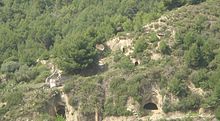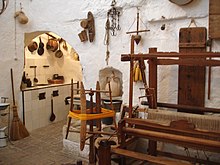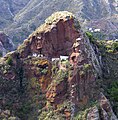Dwelling cave

A dwelling cave is either an inhabited natural cave or an artificial or artificially expanded cavity that is used for residential purposes. Dwelling caves have existed in Europe, Asia and Africa since the Paleolithic . Since the 19th century they have shaped the notion of a level of development for cavemen . The inhabitants of a cave are also known as troglodytes .
Demarcation
Erdhaus (Earth sheltered dwelling) are often referred to in the United States of steel and concrete constructed houses, where more or less thick layers of earth on the roof and / or on a part of the outer walls are applied. The living climate partly corresponds to that of a residential cave. The architect Peter Vetsch also builds such houses, especially in Switzerland. From the outside, they come very close to the design of traditional caves.
Their use also distinguishes them from cave temples and rock-hewn churches that were built exclusively for religious purposes.
properties
construction
The hardness inherent in the solid rock is used in the mostly self-supporting cavities . The stability of the construction depends on the rock in which the cave is dug and the dimensions of the rooms. The underground construction opens up the possibility of enlarging the cave if necessary. Artificial caves are created on slopes to prevent the apartment from filling up when it rains and the water table fluctuates. It is also known as a “house without a roof” or it is referred to as subterranean or subtractive architecture , since most of the stone is removed during construction.
Living environment
The whole year round there are largely balanced, comfortable temperatures that fluctuate around the mean annual outside air temperature of the respective area. The deeper the cave goes into the earth, the lower the annual temperature fluctuations.
There are practically no temperature fluctuations between day and night, as the rock or the surrounding earth acts as a heat store. Due to this effect, the maximum temperatures at a depth of about three meters are felt inside with a delay of up to three months, i.e. not until October, and the minimum temperatures not until April. This changes when the depth is reduced or when there is greater ventilation. The humidity is usually due to the steady temperatures and the buffer function of the surrounding rock around the 50 to 70 percent for homes still pleasant area. It is slightly higher than in conventional apartments at 40 to 60 percent. Usually there is no need for additional thermal insulation , heating or even air conditioning in caves.
sustainability
The construction material expenditure for the creation is low. The energy expenditure for heating or cooling is comparatively small; in southern latitudes it is almost zero with large walls and ceilings.
Watertightness
The density against ingress of moisture depends on the type of soil and the thickness of the cave ceiling as well as the amount of precipitation. In areas in the south of Spain and near Saragossa , quantities fall up to 400 mm (= 400 l / m 2 per year). However, the amount of annual precipitation seems to be less important than the amount of individual peak precipitation events. Occasionally, seals made of concrete or other waterproof materials are also used for poor floors and thin ceilings. For example, the use of is pond liner to imagine or seals that when roofs are used. However, their use is controversial among experts, as the airtightness of these materials makes the subsequent drying by diffusion / evaporation from the cave ceiling into the air above it difficult or impossible. Better experiences were made with overly permeable surface layers with the application of compacted clay.
Radon accumulation in the air
Depending on the natural radioactivity of the soil, the rise of radon from the soil can lead to an accumulation of radon gas, as is also known from cellars . Radon does not accumulate with normal ventilation. If in doubt, you can take measurements of the radon load in the air or consult maps from the responsible radiation protection authority, e.g. the Federal Office for Radiation Protection, beforehand.
Darkness
The lack of daylight is a problem in dwellings in which rooms are dug into the earth in several rows. If the rooms are parallel to the facade, each room can be equipped with daylight openings. For some time now, special light tubes or “skylights” have been offered that can transport daylight up to eight meters deep without noticeable losses in order to provide rooms in the cave a few meters deep with daylight . At the end of the lamp-like device is attached, which has an adjustable, glare-free luminosity.
This system can also be optionally used for ventilation. Other options include enlarging the windows in the facade and installing windows or other transparent elements (glass bricks or blocks) between the inner and outer rooms.
ventilation
Lower-lying rooms can be supplied with the necessary fresh air by means of passive and active ventilation. Passive ventilation uses temperature differences between indoor and outdoor air; z. B. build a ventilation shaft on the side furthest from the entrance. In addition, controllable fans can now also be installed for ventilation.
Spread of dwellings
Excavated caves that are still or re-inhabited can be found in the following places:
- France (including in the Dordogne and Cher département on the banks of the Loire and on the island of Corsica in Pianottoli-Caldarello)
- Spain (Andalusia Guadix , Baza , Granada , Almería ), Valencia city and surroundings, Alicante province ( Crevillente , Rojales ), Aragon ( Saragossa , Jalón valley ), surroundings of Madrid (Fuentidueña de Tajo, Tielmes), Castile ( Albacete ), Canary Islands ( Gran Canaria , e.g. Artenara , Anaga Mountains on Tenerife ), Balearic Islands Mallorca (SaCova near Felanitx, Cala Figuera), Ibiza , Bodegas de Baltanás ( Palencia ).
- Italy ( Ginosa , Gravina in Puglia , Massafra , San Marzano di San Giuseppe in Apulia; Matera , Rabatana in Basilicata; Sulki in Sardinia)
- Greece ( Santorini Island )
- Turkey ( Cappadocia , Göreme ), see also cave architecture in Cappadocia
- Iran ( Kandovan , Maymand )
- Morocco (Bhalil near Sefrou , Imouzzer-Kandar and Zaouia d'Ifrane in the Middle Atlas)
- Libya ( Nalut ) ( Berber dwellings )
- Tunisia ( Matmata , Chenini )
- China ( Loess Plateau , Shanxi ( Zhongyang ) region)
- Australia ( Coober Pedy , White Cliffs )
- USA ( St. Louis )
- Mexico (among the Tarahumara )
- Argentina (Los Riscos) project under construction
They can only be visited as a museum:

- Germany ( cave dwellings Langenstein , Heppenheim , Petershöhle (near Beuron) )
- Switzerland ( Wildenmannlisloch , Kesslerloch , Dieterswil )
- France ( La Madeleine , Maison des Rochers de Graufthal )
- England (Kinver)
- Netherlands (Meerssen, Valkenburg )
- Hungary
- Spain ( Punta de n'Amer , Condado de Treviño , Ciutadella de Menorca (Cala Santandria))
- Italy ( Balzi Rossi in Liguria , Castel Sant'Elia in Latium , Rabatana ( Tursi ) in Basilicata , Massafra in Apulia , Palazzolo Acreide in Sicily )
- Greece (island of Crete Matala )
- Ukraine ( Kiev , Inkerman , Çufut Qale )
- Georgia ( Uplistsiche , Vardzia , Vanis Kvabebi )
- Turkey ( Midyat , Karain )
- Czech Republic ( Valečov )
- Jordan ( Petra )
- USA ( Gila Cliff Dwellings , Mesa-Verde , Montezuma Castle , Walnut Canyon )
In some places, caves are also rented to tourists.
Dwelling caves in fiction
- Cyrano de Bergerac , Journey to the Moon, 1650 ISBN 3-8218-0732-6
- Herbert George Wells , The Future in America, 1911 ISBN 0-548-85971-X
- Jules Verne , Black India, 1877 ISBN 3-8224-1024-1
- Patrick Süskind , Das Parfum , 1985 ISBN 3-257-22800-7
- JRR Tolkien , The Lord of the Rings
- JRR Tolkien , The Hobbit
- Carlo Levi: Christ only came to Eboli, 1944 ISBN 3-423-13039-3
gallery
Residential cave in Coober Pedy , a desert town in South Australia
Loir-et-Cher department , France
Cave dwelling in Rocheménier (France)
Residential caves in Tenerife
Province of Shanxi in the People's Republic of China
Residential caves on Purullena , southern Spain
literature
- Andus Emge: Living in the Goereme Caves . Traditional construction and symbolism in Central Anatolia . Reimer, Berlin 1990, 170 p. With illustrations and a folding plan, kart mU, Cologne ethnological studies; Volume 17, ISBN 3-496-00487-8
- DISTRICT COUNCIL OF COOBER PEDY : Guidelines for the Construction of underground buildings in Coober Pedy ( Memento from June 26, 2004 in the Internet Archive )
- Erhard Wagner, Christoph Schubert-Weller: Earth and cave houses by Peter Vetsch . Niggli, Sulgen 1994, 136 pages, ISBN 3-7212-0282-1 .
- Lambert Karner : Artificial Caves from Ancient Times, Vienna 1903, reprint 2018, ISBN 978-3-96401-000-1 .
- Vladimir Mikulitsch: Stabilization of loess caves in a way that preserves historic monuments - example of the Kiev cave monastery . Karlsruhe 1998, BMBF final report, University of Karlsruhe (TH) - Inst. For Soil Mechanics and Rock Mechanics, available as PDF
- Mike Edelhart: The Earth House . Verlag ORAC, Vienna 1983. (Original English title: The earth house . Dolphin books, 1982, ISBN 3-85368-920-5 )
- Zoelly, Pierre: Terratektur: Entry into the underground architecture. Book
- Carl W. Neumann: In the footsteps of the Ice Age people - [About caves in the Dordogne]. With seven illustrations based on original photographs. In Reclam's Universum - Moderne Illustrierte Wochenschrift 27.1 (1911), pp. 10-13
swell
- Malte Hövel: Cities in Andalusia: settlement statistics, settlement types, geographical determinants Chapter on cave dwellings
- Gerhard Wisnewski : Why people love to live in caves ( memento from October 9, 2006 in the Internet Archive ) . PM Peter Moosleitners Magazin 4/2000, pp. 92–99
Individual evidence
- ↑ See e.g. B. Eduard Peters , Adolf Rieth : The caves of Veringenstadt and their significance for the prehistory and early history of Hohenzollern . In: Association for history, culture and regional studies of Hohenzollern (Hrsg.): Hohenzollerische Jahreshefte. Volume 3. 1936 . Pp. 240-264.
- ↑ Mike Edelhart: The Earth House . P. 82
- ↑ Alleged empirical values of an Andalusian cave renovator
- ↑ Results of the radon outdoor measurements in mining areas ( Memento from March 2, 2009 in the Internet Archive )
- ↑ Loire Valley: cave houses
- ↑ Aldea de Montaña de la Patagonia ( Memento of November 3, 2011 in the Internet Archive )
- ↑ http://de.toprural.com/serci/?cx=014659097291663710340%3Achh78m7oom0&cof=FORID%3A9&q=h%C3%B6hle&sa=earch#955, accessed August 25, 2008
- ↑ Helge Sobik: Original at any price. In: sueddeutsche.de . May 17, 2010, accessed October 13, 2018 .
- ↑ Welcome to the Opal Capital of the World ( Memento from September 19, 2004 in the Internet Archive )
See also
Web links
- Page with further information, pictures and links
- Cave dwelling in the Harz Mountains lived in until 1916
- Video of the MDR "Dug in the lime" about the cave dwelling in Langenstein / Vorharz
- The cave dwellings of Langenstein
- Mom's Subterranean Root Cellar, Bungalow, Mother Earth News, March / April 1982, from Leroy Richter (English)












